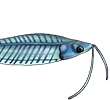Breeding QAs
-
grettonman
- Posts: 25
- Joined: 03 Jan 2006, 09:21
- Location 1: UK
Breeding QAs
I am in the process of setting up a tank to breed QAs and have some questions. The tank I am going to use is a Juwel 300 - 121 x 51 x 73 cm, 300 litres. I intend to have 5 females and 2 males.
Are undergravel filters suitable with the water being filtered through a pair of Eheim 2329-51 Wet/Dry Freshwater Thermo Filters with the water being returned through spray bars. The Ehiems have a quoted output of 1050 litres per hour. Is sufficient flow or do I need more
Are undergravel filters suitable with the water being filtered through a pair of Eheim 2329-51 Wet/Dry Freshwater Thermo Filters with the water being returned through spray bars. The Ehiems have a quoted output of 1050 litres per hour. Is sufficient flow or do I need more
I dont know your filters, but i have spawned QA inn the same type of tank. And i would say that if your O2 level is above 6 ppm, then you should bee in good shape.
In my Juwel rio 300 i have one Eheim 2026, one fluval 404 and one sirculation pump with an airtube, that gives 1000 L/H.
With a temperature at 27 d. celsius i have a O2 level at 10 ppm.
In my Juwel rio 300 i have one Eheim 2026, one fluval 404 and one sirculation pump with an airtube, that gives 1000 L/H.
With a temperature at 27 d. celsius i have a O2 level at 10 ppm.
- MatsP
- Posts: 21038
- Joined: 06 Oct 2004, 13:58
- My articles: 4
- My images: 28
- My cats species list: 117 (i:33, k:0)
- My aquaria list: 12 (i:10)
- My BLogs: 4 (i:0, p:164)
- Spotted: 187
- Location 1: North of Cambridge
- Location 2: England.
I have a Eheim 2028, which I think has the same 1050 lph pump unit, just not the wet/dry & heating units, in a RIO400, and it gives quite good flow, but I'm pretty sure the QA's wouldn't mind if you added a whole lot more flow. I think Janne is using 1800 lph powerheads in his breeding tanks.
I have the original Juwel Jumbo filter providing another 1000 lph, and a separate eheim in-tank 1000 lph circulation pump. Giving a turnover rate of 7-8 times per hour in my tank, and none of the fish seem to mind this flow-rate, including the more docile Satanoperca cf. leucosticta.
I'm sure that QA's can take much more than this, should you wish to do that.
--
Mats
I have the original Juwel Jumbo filter providing another 1000 lph, and a separate eheim in-tank 1000 lph circulation pump. Giving a turnover rate of 7-8 times per hour in my tank, and none of the fish seem to mind this flow-rate, including the more docile Satanoperca cf. leucosticta.
I'm sure that QA's can take much more than this, should you wish to do that.
--
Mats
-
grettonman
- Posts: 25
- Joined: 03 Jan 2006, 09:21
- Location 1: UK
- MatsP
- Posts: 21038
- Joined: 06 Oct 2004, 13:58
- My articles: 4
- My images: 28
- My cats species list: 117 (i:33, k:0)
- My aquaria list: 12 (i:10)
- My BLogs: 4 (i:0, p:164)
- Spotted: 187
- Location 1: North of Cambridge
- Location 2: England.
Thats why i tried to talk about the O2 level. If this is above 6 ppm you could stop adding filters/pumps and see how i turns out. (and soft water).grettonman wrote:I have bred them before with lots of filters to get the turnover of water but I was trying to create a tank that was more pleasing on the eye
- Janne
- Expert
- Posts: 1765
- Joined: 01 Jan 2003, 02:16
- My articles: 10
- My images: 241
- Spotted: 73
- Location 2: Belém, Brazil
- Contact:
To make them breed is not so hard, to make them breed regulary month after month is worse. I cant really agree that 6 ppm O2 is enough, that is considered as a very low oxygen level for fishes but if you can keep it higher then 8 ppm you will see them thrive much better and also breed more regular.
I have species that have spawn 35 times in one year 1 male and 2 females but I dont recomend to let them breed so frequent, they use a lot of energy and they stop growing totally...and it's not good for their health in the long term.
Janne
This is near as perfect it's possible to reach in a tank at that temp. and will make your L260 breed very regular.With a temperature at 27 d. celsius i have a O2 level at 10 ppm.
I have species that have spawn 35 times in one year 1 male and 2 females but I dont recomend to let them breed so frequent, they use a lot of energy and they stop growing totally...and it's not good for their health in the long term.
Janne




